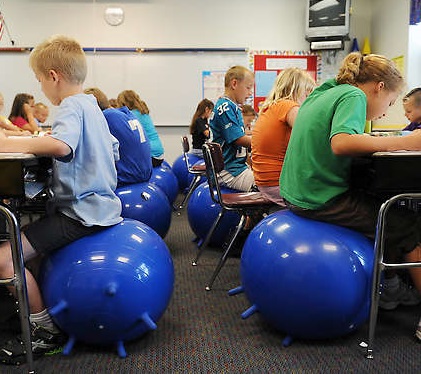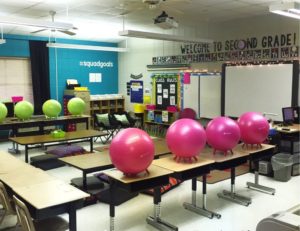We loved this teacher’s honest account of using flexible seating in her classroom. It isn’t as easy as it seems. Allowing our consultants, who have years of Sensory Integration specialization, to guide you through the process, takes the guess work out of flexible seating.
Before you buy that discarded Rocket Ship seat….A cautionary tale about flexible seating.
by Jasmine McClean
Flexible seating is all the rage these days, especially in elementary classrooms. Yes, I drank the juice too and I introduced flexible seating in my 2nd grade classroom. Even though flexible seating was successful, I really wish that I would have done a few things differently before I introduced it in my classroom.
I’m starting to see something that’s a bit concerning. Teachers are so hyped up about flexible seating that they are buying up every pillow, chair, crate, and tire that they can find before ever having read about flexible seating. Not only that, teachers are not making a plan for how to implement this system in their classrooms.
This is your teacher friend here speaking from pure experience when I say to pump your brakes before you begin flexible seating in your classroom. There are a lot of things to consider, and you might not want to “buy all the things” without knowing all the things.
What’s the Fuss over Flexible Seating?
Let’s assume that you know what flexible seating is at this point, so I’m going to spare you the long explanation. Basically, flexible seating transforms the look of traditional classroom seating. Gone are the desks and chairs in favour of pillows, bean bag chairs, stools, and pretty much anything your students can safely sit on.
If you do a quick search on Pinterest, you will see many pictures of classrooms that have been transformed. Instagram is another place to see other teachers’ flexible seating finds and DIY flexible seating projects like tire seats.
This is a picture of my second grade classroom. I implemented flexible seating during the 2016-2017 school and it worked really well for my students…luckily (more on that later). Kayla Delzer explains that research shows that flexible seating “[increases] motivation and engagement.”
Great, so all of my students will be focused on me in the classroom while they bounce around. Awesome, sign me up! Ha, if only it were that easy.
How Are Teachers Messing Flexible Seating Up?
I previously mentioned that flexible seating worked well the first year that it was implemented in my classroom. There are a few things that I did correctly, but I also did several things that could have sabotaged the whole thing. Avoid these things if you are thinking about starting flexible seating in your classroom.
1 Buying all the things: You ain’t got no money, honey! You’re a teacher. Why are you spending all of your Starbucks and student loan money on stuff that might not work? The summer before I implemented flexible seating, I bought so much stuff. Five Below was my second husband and Target was my third child. I bought all of these things because someone else bought them and put them in their classroom. My thought was, “Well they put these pillows in their classroom, so that must mean that it will work in my classroom too.” Instagram be influencing me.
Unless you are looping up with your students, you have no clue what kinds of children are going to walk in your room for the upcoming year. You could potentially buy a ton of flexible seating options that don’t work because your group of kids don’t or can’t vibe with it. I had a few students who were not allowed to use flexible seating because they never used it correctly. You may have students with behavioural issues who could not possibly sit on a crate seat or stability ball. Do you have a plan for those kids? This brings me to my next point…
2 Forgetting to make a plan: The summer before I implemented flexible seating, I read as many blog posts about it that I could find. I did all of this before ever purchasing a single flexible seating item. I really dislike following trends and fads in education without researching them. I tried to figure out what was best to start with. I downloaded free items from Teachers Pay Teachers to teach my students about flexible seating. I found sample letters to send to parents explaining flexible seating. Even with all of this planning, I never stopped to think about the kids who be unsuccessful with flexible seating. Not every kid is going to be able to handle bouncing in a seat all day. The truth is that some kids are going to need to stay in a desk and chair all day. I feel like the blogs and Instagram don’t tell you that part.
Besides having a plan for students who might not be able to participate in flexible seating, you need a plan for implementing it in the classroom PERIOD. If you bought “all the things” and then have to ask someone how you’re supposed to make it work in your classroom, you’re doing it all wrong. You should know how each piece of flexible seating will work within the plan of your classroom before you buy anything.
I messed up because I implemented all of my flexible seating options on the first day of school. I had pillows, lowered tables, stability balls, and traditional desks. We all know that the first day of school is crazy town. It was stressful to model and explain all of our seating options among the countless other things I had to explain the first day. I didn’t have enough traditional desks and chairs for my students to sit in, so I had to tell them about it. They couldn’t sit on the carpet all day!
What I should have done was introduce one type of seating at a time. This would give all the students a chance to practice using it. Yes, they need to practice every single piece of flexible seating that you put in your classroom! If you are a Daily 5 person, you know what I mean when I say they need to build their stamina while using flexible seating as well.
Don’t be mad when little Johnny bounces through the ceiling while on the stability ball on the first day of school. You set your rules and expectations, yeah, but this is a toy to him right now. You have to let your students experience each type of flexible seating, one at a time and then analyze how it’s working. Model, re-direct, set expectations, set consequences… there’s a lot more that goes into flexible seating than throwing random crap into your classroom and calling it flexible seating. This brings me to the next thing that teachers are doing all wrong.
3 Not reflecting on your teaching style, classroom management, and behaviour management: I run a pretty tight ship in my classroom. After my disastrous first year of teaching, I got a handle on my behavior management, and I’ve been good ever since. That being said, I don’t really like too much chaos in my room. Flexible seating somewhat requires you to let go of the traditional thinking that students should sit still in their desks.
In my classroom, you’ll find students laying on the floor, sitting on pillows, rocking on Hokki stools, and bouncing on stability balls. During my first year of implementing flexible seating, I had to remind myself that all of this movement was okay. I had to remind myself A LOT.
Before you decide to implement flexible seating, think about how you like your classroom to run. For some teachers, all of the movement that can take place with flexible seating might be a little bit too much. If that’s you, don’t do flexible seating.
Likewise, you need to honestly assess how efficiently you run your classroom. I’m talking about classroom management and behaviour management here, folks. Mrs. Russell has made a clear distinction between classroom management and behaviour management. You better check yourself before you wreck yourself. Let me be frank, teacher friend…if your management sucks is not on par, flexible seating is not for you right now. If you can’t control your class now, do you think you’ll be able to control 20 bouncing kids? If you don’t have procedures for everything in your classroom, do you think you’ll be able to develop a system to make sure every child has a fair turn using your flexible seating options?
Hopefully, I’ve given you a little food for thought before you implement flexible seating. Remember, not every trend and popular idea you see on the blogs, Pinterest, Facebook, and Instagram is a right fit for you as a teacher or your classroom. This was not a bashing session for flexible seating. It was more of a what-not-to-do guide for those who are interested in flexible seating. So before you spend a cool buck on that discarded rocket ship seat you saw on Craigslist that would make the perfect addition to your flexible seating classroom, make sure you are crystal clear about how it will work in your classroom. Flexible seating has been so successful in my classroom that I have declared to several of my colleagues that I’ll never go back to traditional seating. Flexible seating requires some trial and error, but keep some of my suggestions in mind if you’re on the fence about starting it in your classroom.
This post originally appeared on the blog Tame the Classroom.

